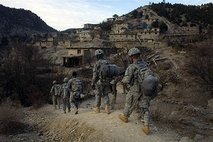 KABUL – Afghan officials said U.S.-ordered bombing runs killed dozens of civilians taking shelter Tuesday from a battle with Taliban militants, and villagers took several truckloads of bodies to show the provincial governor. The U.S. promised a joint investigation.
KABUL – Afghan officials said U.S.-ordered bombing runs killed dozens of civilians taking shelter Tuesday from a battle with Taliban militants, and villagers took several truckloads of bodies to show the provincial governor. The U.S. promised a joint investigation.
A provincial councilman said he saw about 30 bodies, many of them women and children.
Overall death toll estimates varied widely. Villagers estimated from 70 to well over 100 civilians may have died, according to local and regional officials. But no government official could confirm such a toll.
Civilian deaths have caused increasing friction between the Afghan and U.S. governments, and President Hamid Karzai has long pleaded with American officials to reduce the number of civilian casualties in their operations. Karzai meets with President Barack Obama in Washington on Wednesday.
In remarks at a Washington think tank Tuesday, Karzai alluded to the problem of civilian casualties without mentioning the bombing deaths. He said the success of the new U.S. war strategy depends on “making sure absolutely that Afghans don’t suffer — that Afghan civilians are protected.”
“This war against terrorism will succeed only if we fight it from a higher platform of morality,” he added in a speech at the Brookings Institution. Asked later what he meant by that remark, Karzai said, “We must be conducting this war as better human beings,” and recognize that “force won’t buy you obedience.”
The latest fighting broke out Monday soon after Taliban fighters — including Taliban from Pakistan and Iran — massed in Farah province in western Afghanistan, said Belqis Roshan, a member of Farah’s provincial council. The provincial police chief, Abdul Ghafar, said 25 militants and three police officers died in that battle near the village of Ganjabad in Bala Baluk district, a Taliban-controlled area near the border with Iran.
Villagers told Afghan officials that they put children, women, and elderly men in several housing compounds in the village of Gerani — about three miles to the east — to keep them safe. But villagers said fighter aircraft later targeted those compounds, killing a majority of those inside, according to Roshan and other officials.
The top U.S. spokesman in Afghanistan, Col. Greg Julian, confirmed that U.S. coalition forces participated in the battle. Julian said five wounded Afghans sought medical treatment at a military base in Farah.
“We offer our condolences to those affected by today’s operations and will immediately investigate the claims to determine what happened,” Julian said.
State Department spokesman Robert Wood said in a statement later Tuesday, “The United States deeply regrets any injury or loss of life among innocent Afghans resulting from operations in which its forces are involved.”
Abdul Basir Khan, another member of Farah’s provincial council, said Farah’s governor had hoped to send a delegation to the bombing site Tuesday to investigate, but that officials decided not to go because of how dangerous the region was. It wasn’t clear when investigators might reach the village.
The United Nations often takes a lead role in investigating high-profile civilian death cases, but the U.N. doesn’t have any officials in Farah province.
A Western official in Kabul said Marine special operations forces — which fall under the U.S. coalition — had called in the airstrikes. The official asked not to be identified because he wasn’t authorized to release the information.
Khan said villagers brought bodies, including women and children, to Farah city to show the province’s governor. Khan estimated that villagers brought about 30 bodies.
“It was difficult to count because they were in very bad shape. Some had no legs,” Khan said.
Farah’s hospital treated at least three wounded villagers, including an 11-year-old boy whose chest, arms and shoulders were completely bandaged. A girl named Shafiqa had bandages under her chin. Two of her toes were severed in the fighting.
“We were at home when the bombing started,” she told AP Television News. “Seven members of my family were killed.”
Khan said villagers told him more than 150 civilians had died, but he said he had no way to know whether that claim was true.
The issue of civilian deaths is complicated in Afghanistan. Journalists and human rights workers can rarely visit remote battle sites to verify claims of civilian casualties. U.S. officials say Taliban militants sometimes force villagers to lie and say civilians have died in coalition strikes.
But the villagers’ claims on Tuesday were bolstered by the wounded at Farah’s hospital shown on AP Television News. And Khan’s account of several truckloads of bodies taken to Farah city added more weight to the claims.
Mohammad Nieem Qadderdan, the former top official in the district of Bala Baluk, said he saw dozens of bodies when he visited the village of Gerani.
“These houses that were full of children and women and elders were bombed by planes. It is very difficult to say how many were killed because nobody can count the number, it is too early,” Qadderdan, who no longer holds a government position, told The Associated Press by telephone. “People are digging through rubble with shovels and hands.”
Qadderdan said the civilian casualties were “worse than Azizabad,” a reference to an August 2008 strike in a district immediately to the north of Bala Baluk.
An Afghan government commission found that an operation by U.S. forces killed 90 civilians in Azizabad, a finding backed by the U.N. The U.S. originally said no civilians died; a high-level investigation later concluded 33 civilians were killed.
After the Azizabad killings, the top U.S. commander in Afghanistan, Gen. David McKiernan, announced a directive last September meant to reduce such deaths. He ordered commanders to consider breaking away from a fire-fight in populated areas rather than pursue militants into villages.
 Eurasia Press & News
Eurasia Press & News


